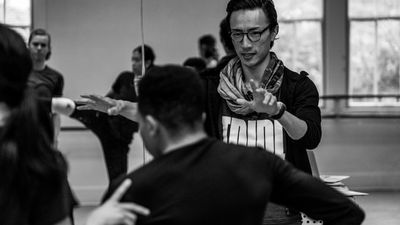World-Renowned Japanese Choreographer Sakuraba’s World Premiere Highlights 'Coincide' Dance Event
ON SATURDAY, APRIL 29, Houston Contemporary Dance Company presents Coincide, an evening of dance by some of the country’s most celebrated choreographers, including works by Eoghan Dillon and Andrea Dawn Shelley, and two world premieres by Alexander Anderson and Yoshito Sakuraba.
Performed with passion and finesse by HCDC’s company members and guest artists, the eclectic program brings together a diverse cross-section of dancemakers, each with a unique vision of how movement can tell a story and express an emotion or be as abstract as painting or sculpture. The evening also features a dance-on-film by Houston’s own Hope Stone Dance, which is now celebrating its 25th year of dance-making.
HCDC founding artistic and executive director Marlana Doyle, who makes it a point to meet and remain in touch with an ever-expanding network of living choreographers, met Sakuraba years ago and reconnected with him in 2019 when he was a guest choreographer at HSPVA. Born and raised in Aomori, Japan, the now New York-based Sakuraba grew up in an environment where there were no dance studios and no venues to see live dance, ballet or even a musical. “I’ve heard there’s one hip-hop studio in my town that’s pretty good,” says Sakuraba. “But there’s no ballet. I don’t think anybody in my town has ever seen ballet or concert dance.”
After relocating to the U.S. in 2000 at age 19, Sakuraba studied painting and photography, two mediums that continue to influence his choreography. Sakuraba often begins the creation of a piece by staging a single, simple image, such as an empty chair downstage, and a single figure behind it, and then explores and expands on that image by moving the dancers around. “It’s like painting,” says Sakuraba. “You step back and then decide what color you’re going to use next.” Sometimes the movement is slow, and stately, like a film running in slow motion; other times, his dancers, partnered or as an ensemble, execute complex and theatrical gestures with frightening speed and grace.
For his collaboration with HCDC, Doyle suggested Sakuraba explore climate change as a theme, albeit in his own idiosyncratic language. A short reel shared on Sakuraba’s Instagram shows a bit of the work-in-progress: a woman walks slowly and with great effort, as if caught in a windstorm, turning her head and protecting her face with her hands, while behind her, two dancers hold up a billowing American flag. While Sakuraba does use the word “apocalyptic” to describe the new piece, he typically stays away from making literal, political statements, preferring instead to create a more mysterious experience. “The least I can do is keep making work,” says Sakuraba when asked how art can respond to an issue as overwhelming as climate change.
Since his first tentative steps in the U.S. as a teenager who spoke little English, Sakuraba has gone on to show his work in Germany, Poland, Italy, Spain, Israel, Mexico, and at venues across the U.S., including Joyce Theater, Jazz at Lincoln Center and Jacob's Pillow. But he has no plans to try to produce something in his native country, where pop culture reigns supreme, and a 40-something, non-traditional dancer who pulls from so many different artistic mediums can feel like an outsider.
Well, does his mother appreciate his work?
“I don’t think so,” laughs Sakuraba. “I sent her a link to my work and she said she didn’t understand it. So I give up.”
Houston Contemporary Dance Company (photo by Morteza)
